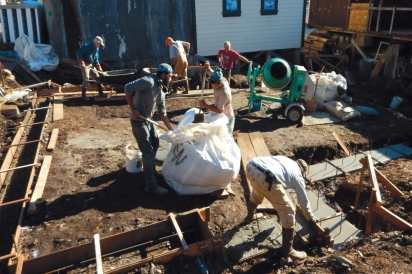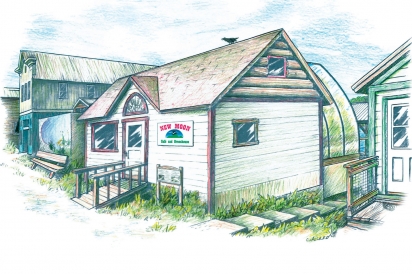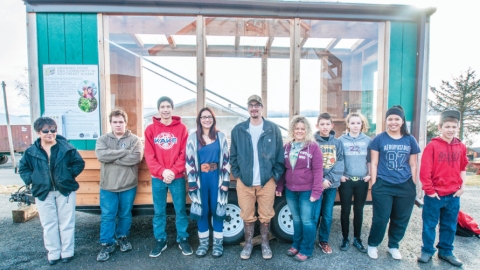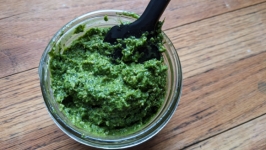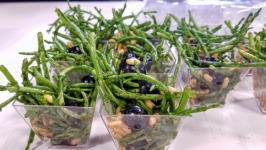From the Ground Up
A Geothermally Heated Greenhouse in Tenakee Springs
On a warm spring day, I stand beside the cypress-wood gothic arch of Tenakee Springs’ new geothermally heated greenhouse, discussing the possibility of Alaska-grown lilikoi. “I’d like to try lemons, mandarins, and even passion fruit in here,” says Kevin Allred, designer and builder of the greenhouse and adjacent café. His wife, Carlene, has more modest goals: “I’d like to grow sweet potatoes,” she tells me. It all sounds fantastical—tropical plants in Southeast Alaska? And yet, implausible ideas become reality when Kevin Allred takes them on.
A short and energetic 60-something, Kevin looks like just another quirky, rural Alaskan in worn jeans and a t-shirt, with a propensity for dumpster diving and ridiculous pranks (right now, a ghostly motion-detecting arm opens and closes the café’s upstairs window curtain whenever anyone passes by—it’s Harry Dorke, the café’s original owner, watching us). Yet behind Kevin’s unassuming coutenance is an eclectic résumé—from homesteader to mechanic to caver. Kevin and Carlene are both renowned spelunkers who have explored and mapped over 500 caves in Southeast Alaska. Kevin was the first to the bottom of El Capitan Pit, the deepest vertical shaft in Alaska.
After raising five children off the grid near Haines, Kevin and Carlene moved to downtown Tenakee Springs, for what Carlene calls “the easy life.” Tenakee Springs is a Southeast Alaskan fishing village nestled in the protected, inside waters of Chichagof Island with a year-round population of 70 people. The town was founded and named for the geothermal springs bubbling at its center. A bathhouse encloses the main spring, where residents and visitors soak in the 102° F pool. Surrounding the bathhouse are Tenakee’s only public businesses: the Tenakee Springs Market, the post office, the Alaska Seaplanes office, the fuel dock and, for over 100 years, Blue Moon Café.
Housed in a derelict log cabin, the café served generations of fishermen, cannery workers, and miners. When 78-year-old Rosie Floresca, Blue Moon Café’s decades-long proprietor, moved away, the Allreds approached the family to purchase the property. They wanted to build a heated greenhouse that could provide fresh produce for the community year-round. In Tenakee’s remote location, especially with decreased ferry service, fresh vegetables in winter are a precious commodity. Kevin and Carlene had just returned from Prince of Wales, inspired by the heated aquaponic greenhouses run there by the Southeast Island School District. The district used second-growth lumber accessible by logging road to heat their greenhouses. Kevin says he thought, “I wonder if we could adapt that idea using geothermal.”
For many folks, such a project would be an insurmountable pipe dream. When the Alaska Energy Authority surveyed Tenakee’s geothermal energy potential, they declared the spring’s heat and volume insufficient as an energy source. But Kevin began tinkering— just to see. He had no formal training or experience in geothermal energy, but after years of cutting down firewood to heat his home, he was excited about free, no-labor-necessary heat. Ten years later, he has installed clean geothermal heat in his own residence, the bathhouse dressing room, the Tenakee Springs Market and its neighboring warehouse, the museum, and several other residences.
Over the past two years, Kevin has transformed Blue Moon Café. He initially planned to repair the original log cabin, but he quickly discovered that it was rotten all the way to its foundation. The building, like the adjacent community bathhouse, sits on land sanctioned as a national historic site, which means any changes to the original structure or purpose need Bureau of Land Management (BLM) approval. Kevin wanted a geothermal greenhouse; the BLM required it to stay in its historical form, as a log cabin café. Eventually, however, the BLM agreed to let Kevin rebuild, with stipulations: he must use some of the original logs, it must remain a café, and Kevin must display interpretive signs and provide a historical brochure. Once he had the go-ahead, Kevin took off, and now “New Moon Café” and the adjacent greenhouse are almost complete.
Heating the greenhouse was Kevin’s greatest challenge. On the beach below the building, near the high tide line, Kevin found a usable seep. He dug down to bedrock to install a pipe and pump. Hot water flows directly into the greenhouse and café floors, heating the building. But this direct-heat system has its challenges. If oxygen mixes in the spring, bacteria grows, feeding off hydrogen sulfide, the rotten-egg-smelling gas we associate with hot springs. This bacteria gums up the pipes. To keep pipes clear, no oxygenated surface water or air can touch the spring water as it is pumped to the surface and through the pipes. To compound this problem, the high-pressure spring is filled with gas that must be let out. “It’s like a soda,” Kevin explains. “Carbon dioxide bubbles create gas which must be eliminated without adding oxygen.” To fix this, Kevin has installed a series of valves and air vents. Now, however, he’s noticed a new problem: “I had [the spring water] coming out of the pipe, but now it’s coming out next to it. I’m going to have to go find the leak.” This means once again digging and following the bedrock. “I’m always scared this could mess up the main spring. I don’t know what I’ll find.”
The organizational plan for the café and greenhouse is still to be determined. Will it be a free public space, like a community garden? Will the whole thing be a commercial operation? How will the café part work with the greenhouse?
Kevin seems happy to leave these questions for later—perhaps for the manager he envisions running the café and greenhouse. “You have to have a champion or the project will die,” Kevin tells me. Long term, he doesn’t see himself as that champion; his interest was to build a community space. He wants to hand the completed project to a local nonprofit that could guarantee it remains a community asset. In small towns, often a motivated, excited person builds something great— whether a structure or a community organization—but then they leave, pass away, or just move on, and the project is abandoned. There are rarely enough people to fill the voids others leave behind. Kevin understands this well. A few years ago, Kevin and Carlene visited a Tenakee-sized community in the Aleutians that had a new community greenhouse. “The place was just a metal frame with tatters of Visqueen. Someone was excited, and then that person moved away and it just fizzled,” Kevin says. Even the Prince of Wales greenhouses, the thriving community/ school endeavor that first inspired Kevin, has since shut down. A new school administration came in, with different priorities.
For now, though, community support has been overwhelming. Volunteers have contributed countless hours on tasks ranging from mixing cement to carpentry to running “GoFundMe” campaigns. The Chichagof Conservation Council (CCC) has worked with Kevin to secure grant funding. “My role and CCC’s role has been to raise funds,” CCC Board Member Molly Kemp explains. “CCC was formed in the pulp mill days and for a lot of years all we could do was say no to dangerously misguided logging projects.” Now, CCC has the opportunity to support community sustainability projects such as this one. “Local food security is right in line with resource conservation. It doesn’t make sense to fly in lettuce from California and ginger from Hawaii when we can grow them ourselves.”
Tenakee gardeners are excited about winter vegetables and lengthened growing seasons. Others have begun looking into the new greenhouse’s potential for adding to the locally grown food economy: last summer, as an experiment, Kemp stuck a piece of store-bought ginger in a pot. It grew wildly in the windowsill of the Allreds’ geothermally heated home, and has inspired the idea of Alaska-grown ginger. “I’ve talked to three potential buyers who would jump at the idea of locally grown ginger,” Kemp says. Still other locals look forward to the positive community benefits: a green, flower-filled space in which to gather on grey, mid-winter days.
As the project nears completion, more and more Tenakee residents clamor to get involved, excited by the vision Kevin has been quietly realizing. This is good news for Kevin, who wants to see his building used and loved, but isn’t keen to run it himself. Instead, Kevin tells me about another idea: to dive down to the deeper ocean floor, towing a thermometer that he hopes would help him find additional hot spots. “There could be potential for heating this whole town!” he exclaims.
I can picture Tenakee in two years: Kevin’s greenhouse is lush and verdant, filled with community members jamming on instruments or playing cards. Meanwhile, Kevin wanders towards the ocean in wetsuit and dive gear. As Tenakee residents enjoy his latest impossible idea, Kevin plunges towards new questions that the rest of us have not even thought to ask.



